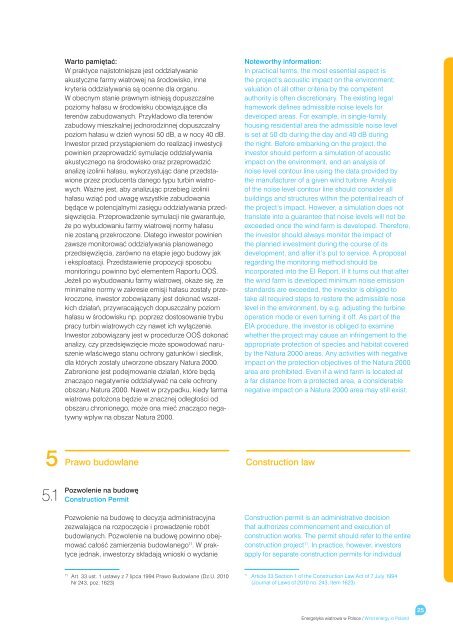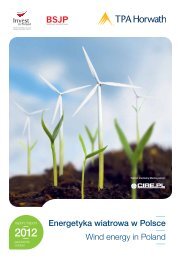Energetyka wiatrowa w Polsce Wind energy in Poland - TPA Horwath
Energetyka wiatrowa w Polsce Wind energy in Poland - TPA Horwath
Energetyka wiatrowa w Polsce Wind energy in Poland - TPA Horwath
Create successful ePaper yourself
Turn your PDF publications into a flip-book with our unique Google optimized e-Paper software.
5<br />
5.1<br />
Warto pamiętać:<br />
W praktyce najistotniejsze jest oddziaływanie<br />
akustyczne farmy wiatrowej na środowisko, <strong>in</strong>ne<br />
kryteria oddziaływania są ocenne dla organu.<br />
W obecnym stanie prawnym istnieją dopuszczalne<br />
poziomy hałasu w środowisku obowiązujące dla<br />
terenów zabudowanych. Przykładowo dla terenów<br />
zabudowy mieszkalnej jednorodz<strong>in</strong>nej dopuszczalny<br />
poziom hałasu w dzień wynosi 50 dB, a w nocy 40 dB.<br />
Inwestor przed przystąpieniem do realizacji <strong>in</strong>westycji<br />
pow<strong>in</strong>ien przeprowadzić symulacje oddziaływania<br />
akustycznego na środowisko oraz przeprowadzić<br />
analizę izol<strong>in</strong>ii hałasu, wykorzystując dane przedstawione<br />
przez producenta danego typu turb<strong>in</strong> wiatrowych.<br />
Ważne jest, aby analizując przebieg izol<strong>in</strong>ii<br />
hałasu wziąć pod uwagę wszystkie zabudowania<br />
będące w potencjalnymi zasięgu oddziaływania przedsięwzięcia.<br />
Przeprowadzenie symulacji nie gwarantuje,<br />
że po wybudowaniu farmy wiatrowej normy hałasu<br />
nie zostaną przekroczone. Dlatego <strong>in</strong>westor pow<strong>in</strong>ien<br />
zawsze monitorować oddziaływania planowanego<br />
przedsięwzięcia, zarówno na etapie jego budowy jak<br />
i eksploatacji. Przedstawienie propozycji sposobu<br />
monitor<strong>in</strong>gu pow<strong>in</strong>no być elementem Raportu OOŚ.<br />
Jeżeli po wybudowaniu farmy wiatrowej, okaże się, że<br />
m<strong>in</strong>imalne normy w zakresie emisji hałasu zostały przekroczone,<br />
<strong>in</strong>westor zobowiązany jest dokonać wszelkich<br />
działań, przywracających dopuszczalny poziom<br />
hałasu w środowisku np. poprzez dostosowanie trybu<br />
pracy turb<strong>in</strong> wiatrowych czy nawet ich wyłączenie.<br />
Inwestor zobowiązany jest w procedurze OOŚ dokonać<br />
analizy, czy przedsięwzięcie może spowodować naruszenie<br />
właściwego stanu ochrony gatunków i siedlisk,<br />
dla których zostały utworzone obszary Natura 2000.<br />
Zabronione jest podejmowanie działań, które będą<br />
znacząco negatywnie oddziaływać na cele ochrony<br />
obszaru Natura 2000. Nawet w przypadku, kiedy farma<br />
<strong>wiatrowa</strong> położona będzie w znacznej odległości od<br />
obszaru chronionego, może ona mieć znacząco negatywny<br />
wpływ na obszar Natura 2000.<br />
Prawo budowlane Construction law<br />
Pozwolenie na budowę<br />
Construction Permit<br />
Pozwolenie na budowę to decyzja adm<strong>in</strong>istracyjna<br />
zezwalająca na rozpoczęcie i prowadzenie robót<br />
budowlanych. Pozwolenie na budowę pow<strong>in</strong>no obejmować<br />
całość zamierzenia budowlanego 11 . W praktyce<br />
jednak, <strong>in</strong>westorzy składają wnioski o wydanie<br />
11 Art. 33 ust. 1 ustawy z 7 lipca 1994 Prawo Budowlane (Dz.U. 2010<br />
Nr 243, poz. 1623)<br />
Noteworthy <strong>in</strong>formation:<br />
In practical terms, the most essential aspect is<br />
the project’s acoustic impact on the environment;<br />
valuation of all other criteria by the competent<br />
authority is often discretionary. The exist<strong>in</strong>g legal<br />
framework def<strong>in</strong>es admissible noise levels for<br />
developed areas. For example, <strong>in</strong> s<strong>in</strong>gle-family<br />
hous<strong>in</strong>g residential area the admissible noise level<br />
is set at 50 db dur<strong>in</strong>g the day and 40 dB dur<strong>in</strong>g<br />
the night. Before embark<strong>in</strong>g on the project, the<br />
<strong>in</strong>vestor should perform a simulation of acoustic<br />
impact on the environment, and an analysis of<br />
noise level contour l<strong>in</strong>e us<strong>in</strong>g the data provided by<br />
the manufacturer of a given w<strong>in</strong>d turb<strong>in</strong>e. Analysis<br />
of the noise level contour l<strong>in</strong>e should consider all<br />
build<strong>in</strong>gs and structures with<strong>in</strong> the potential reach of<br />
the project’s impact. However, a simulation does not<br />
translate <strong>in</strong>to a guarantee that noise levels will not be<br />
exceeded once the w<strong>in</strong>d farm is developed. Therefore,<br />
the <strong>in</strong>vestor should always monitor the impact of<br />
the planned <strong>in</strong>vestment dur<strong>in</strong>g the course of its<br />
development, and after it’s put to service. A proposal<br />
regard<strong>in</strong>g the monitor<strong>in</strong>g method should be<br />
<strong>in</strong>corporated <strong>in</strong>to the EI Report. If it turns out that after<br />
the w<strong>in</strong>d farm is developed m<strong>in</strong>imum noise emission<br />
standards are exceeded, the <strong>in</strong>vestor is obliged to<br />
take all required steps to restore the admissible nose<br />
level <strong>in</strong> the environment, by e.g. adjust<strong>in</strong>g the turb<strong>in</strong>e<br />
operation mode or even turn<strong>in</strong>g it off. As part of the<br />
EIA procedure, the <strong>in</strong>vestor is obliged to exam<strong>in</strong>e<br />
whether the project may cause an <strong>in</strong>fr<strong>in</strong>gement to the<br />
appropriate protection of species and habitat covered<br />
by the Natura 2000 areas. Any activities with negative<br />
impact on the protection objectives of the Natura 2000<br />
area are prohibited. Even if a w<strong>in</strong>d farm is located at<br />
a far distance from a protected area, a considerable<br />
negative impact on a Natura 2000 area may still exist.<br />
Construction permit is an adm<strong>in</strong>istrative decision<br />
that authorizes commencement and execution of<br />
construction works. The permit should refer to the entire<br />
construction project 11 . In practice, however, <strong>in</strong>vestors<br />
apply for separate construction permits for <strong>in</strong>dividual<br />
11 Article 33 Section 1 of the Construction Law Act of 7 July 1994<br />
(Journal of Laws of 2010 no. 243, Item 1623)<br />
<strong>Energetyka</strong> <strong>wiatrowa</strong> w <strong>Polsce</strong> / <strong>W<strong>in</strong>d</strong> <strong>energy</strong> <strong>in</strong> <strong>Poland</strong><br />
25



